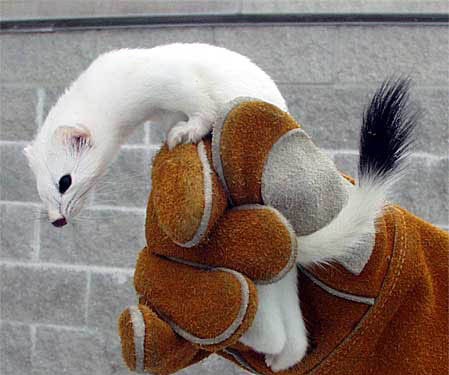
Stoat(Mustela erminea)
Phylum —chordata
Class — mammalia
Order — carnivora
Family — mustelidae
Genus – mustela
Appearance
The stoat has an elongated neck, the head being set exceptionally far in front of the shoulders. The trunk is nearly cylindrical, and does not bulge at the abdomen. The skull, although very similar to that of the least weasel, is relatively longer, with a narrower braincase. The projections of the skull and teeth are weakly developed, but stronger than those of the least weasel. The eyes are round, black and protrude slightly. The whiskers are brown or white in colour, and very long. The ears are short, rounded and lie almost flattened against the skull. The claws are not retractable, and are large in proportion to the digits. Each foot has five toes. Fat is deposited primarily along the spine and kidneys, then on gut mesenteries, under the limbs and around the shoulders. The stoat has four pairs of nipples, though they are visible only in females.
Sexual dimorphism in size is pronounced, with males being roughly 25% larger than females and 1.5-2.0 times their weight. On average, males measure 187–325 mm (7.4–12.8 in) in body length, while females measure 170–270 mm (6.7–10.6 in). The tail measures 75–120 mm (3.0–4.7 in) in males and 65–106 mm (2.6–4.2 in) in females. Males average 258 grams (9.1 oz) in weight, while females weigh less than 180 grams (6.3 oz).
The winter fur is very dense and silky, but quite closely lying and short, while the summer fur is rougher, shorter and sparse. In summer, the fur is sandy-brown on the back and head and a white below. The stoat moults twice a year. In spring, the moult is slow, starting from the forehead, across the back, toward the belly. In autumn, the moult is quicker, progressing in the reverse direction. In the stoat's northern range, it adopts a completely white coat (save for the black tail-tip) during the winter period. Differences in the winter and summer coats are less apparent in southern forms of the species. In the species' southern range, the coat remains brown, but is denser and sometimes paler than in summer.
Habitat
Stoats are found across the northern subarctic, Arctic and temperate regions of Asia, Europe, and North America. Across the New World, they are distributed from west to east in a wide belt running from the Arctic Ocean and nearby islands in the Canadian Archipelago south to the northern United States. They are not found on the Great Plains.
Behavior
This species is largely crepuscular or nocturnal but is sometimes active during the day. Stoats are good climbers and they use trees when escaping predators, resting, and searching for food.
They are largely solitary. They are territorial and intolerant of other stoats in their range, particularly those of the same gender. Within their range, they typically use several dens, often those of their prey species. They usually travel alone, except when mating mothers with their older offspring. Adult males will dominate females and young. The females generally remain in the area of their birth throughout their lives. The males disperse and secure a large territory that usually encompasses or overlaps females' territories. This species maintains exclusive boundaries that they patrol and mark with scent.
They have keen senses of sight, hearing, smell, and touch that help to locate prey.
Diet
Stoats are carnivores and prey on small, warm-blooded vertebrates, particularly mammals the size of rabbits or smaller. When mammals are scarce, they eat birds, eggs, fish, frogs, and insects.
Reproduction
Stoats are polygynandrous, with both males and females mating with multiple partners. They mate from late spring to early in the summer. Females bear 1 litter only per year. After gestation of around 280 days, young are born during April or May. Gestation includes a period of developmental delay of 8 to 9 months. Litter sizes range from 3 to 18 and average 4 to 9. Young grow quickly and can hunt with their mothers when 8 weeks old. Weaning takes place at around 10 weeks. Females reach adult size by about 6 weeks after birth, and are able to mate at 60 to 70 days of age, often before being weaned. Males gain adult size during their second summer.
The average life span of a stoat is 1 to 2 years; the maximum is 7 years.
In captivity
Stoats are very well tamed. Thanks to their hyperactivity, they will amuse you from morning till evening.
The cage for the stoat must have a very small distance between the bars, otherwise the animal will run out of it.
Food for the stoat is best balanced like one for cats or ferrets. At least once or twice a week, you must give a live or dead rat or chicken. You may give a raw chicken. In captivity, the stoat eats 50-75 g of meat or 2-3 voles a day. In general, the amount of meat food consumed per day exceeds half of its own weight. Once a week, the keepers should arrange fasting days for stoats.
 Russian
Russian
 English
English























